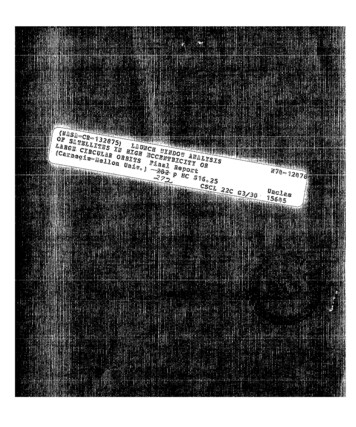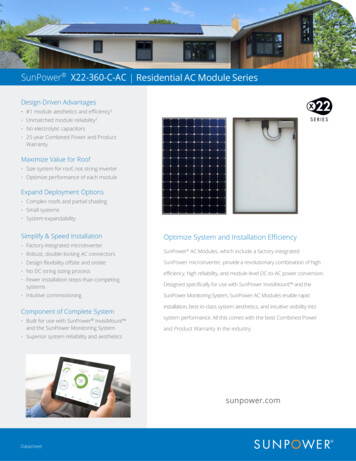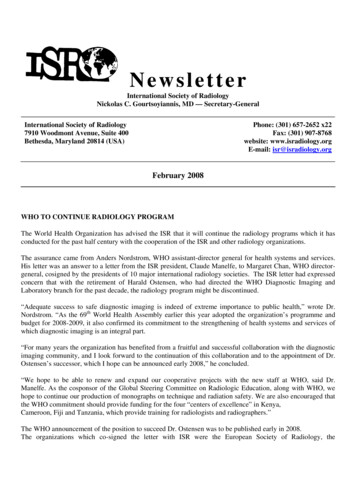
Transcription
1OPXC3-eBS5SS4f X22UPIM%"LacjaZuHX uI
Carnegie-Mellon UniversityApplied Space Sciences ProgramFINAL REPORTNASANGR-3q-087-001Launch Window Analysis of Satellitesin High Eccentricity orLarge CircularOrbitsbyMarc L. Renard (Principal Investigator)S.K. BhateR. SridharanSeptember 15, 1973Dr. Marc L. RenardAssociate Prof. ofApplied Space Sciencesand Electrical Engineering
ACKNOWLEDGEMENTSThe authors are very indebtedto S.J. Paddack, of theIMP-Projects Office of NASA Goddard Space Flight Center, for manyfruitful discussions and for providing us with high accuracy computerorbits and other needed data.Thanks are also due to G. Fried forsending us reference computerresults, and to L. Carpenter withwhom some aspects of the present work were discussed.The efficient help of Cheryll M. Conaway in typing and editingthis manuscript and many reports and papers, duringthis grant, is gratefully acknowledged.the course of
TABLE OF CONTENTSPage No.Cover PageAcknowledgementsTable of ContentsChapter 1Purpose of this work1-1 to 1-2Chapter 2Method of Approximate StabilityCriteria2-1 to 2-72Chapter 3A Study of Orbits of LargeElectricity Quasi-Normal to theEcliptic3-1 to 3-42Chapter 4A Modified Lidov's Method byNon-Numeric Computation, withApplication4-1 to 4-83Appendix A-iEffect of Earth's OblatenessA1.1 to Al.14Chapter 5Singularity-free Methods, UsingRegularization, for Circularand Elliptic Orbits5-1 to 5-44Appendix A-2Auxiliary Developments inSingularity-Free MethodsA-2.1 to A-2.5Chapter 6Orbital Programs6-1 to 6-14Chapter 7General Conclusions7-1 to 7-2'/
CHAPTER 1Purpose of this WorkMuch of what we presently know about "deep space", and the variousphysical phenomena resulting from the interaction of the earth'smagnetic field with the solar wind, has been obtained from experimentalevidence gathered by satellites of the EXPLORER series (IMP, forinterplanetary monitoring probes).In order to probe, along the same orbital period of a few days,the near-earth region, the transition region and free interplanetaryspace, it is convenient to use satellites in geocentric orbits of verylarge eccentricity, typically in the range of eccentricities0.9e,0.95.Suchorbits present a critical "stability" problem.Their initially low height of perigee is so perturbed by the gravivational effects of the sun and the moon that only a judicious choice ofthe launch time can guarantee that the satellite orbit will not experience a premature decay in the earth's atmosphere.The determinationof these times, or "launch window calculation" had very often beextremely costly proposition if high accuracy numerical integrationprograms were used.On the other hand, such computation istive when the "target dates" are better known.impera-The present workaimed at providing the mission analysts with methods and computingtools for studying the stability and evolution of orbits of large eccentricity.This is the topic ac Chapters 2, 3 and 4.Chapters 2 and 3
1-2develop an approach for a lower accuracy, but very fast analysistechnique, whereas Chapter 4 resorts to non-numeric omputation toobtain a "symbolic theory", applicable to high eccentricity orbitsand of average accuracy and computer-time requirements.Deep space is also investigated by means of satellites inlarge circular orbits (20 earth's radii, say), which are similarlyperturbed by the sun and the moon.Although orbital decay is nota practical problem here, the development of methods of orbitalcomputation, which would be more economical than conventionalones, allow for strong perturbations and be singularity-free,appearedto be a topic of much relevance.Such is the subjects of Chapter 5.Chapter 6 implements the methods of the previous one, and comparesthem to a straight method of variation of parameters, with time asthe independent variable.It is hoped that the approaches and techniques suggested in thiswork will be of help to the mission analyst facing the challenge offuture space missions.
2-1CHAPTER 2Method of Approximate Stability Criteria2.1The ProblemIn the pre-launch phase of the mission analysis of satellitesin orbits of large eccentricity, there exists a definite need formethods of determination of the orbital stability which would combineEXTREME COMPUTING SPEED with TOLERABLE accuracy on the results.To be more specific,agiven a launcher of known capabilities,launch site, a spacecraft of (roughly)known mass,an orbit of knownin-plane geometry (i.e. the initial semi-major axis and eccentricitye),one wishes to "design" an orbit by adjusting, within limits,- the orbital inclination on the equator (ia)- the argument of perigee, referred to the equator (wm)- the time (hour; day; year) of launch (which in turn permitscomputation of the longitude of nodes, Q., and the time ofpassage at perigee, Tp)while satisfying,as explained inmore detail inthe previous chapter,- a lifetime constraint- other constraints of a technical scientific or operationalnature (for instance: the angle between the satellite spinaxis and the earth-sun line, or solar aspect angle, shouldbe 900 150, say, at injection)Now it should be remembered that the "lifetime constraint" isrelatively imprecise and can often, to some extent, be relaxed.Arequirement that the lifetime be "3 years" is not meant to be taken
2-2as a request that the reentry of the satellite into the earth's atmosphere occur at time t time of launch 1,095.75 days.Therefore, someinaccuracy on the a-priori determination of the lifetime might be tolerable when balanced against the speed and economy with which the predictioncan be made.If a method of extremely high economy is indeed obtained, parametricstudies and the "mass production" of launch windows becomes practical.Questions such as this one can be readily answered:"Given this constrainton the solar aspect angle, when in the year 1973 should we launch thissatellite so as to fulfill all constraints?What is the penalty paid inlifetime if we make the solar aspect angle condition more stringent?Shouldwe try to modify the ascent phase and obtain a different argument of perigeeetc.In addition to looking, in this chapter, to a method of appreciablyreducing the computing time necessary for obtaining a launch window map,the accent will be put also, as initially proposed[2-1][, on automatizingthe graphical presentation of the output in the form most suitable to theusers' needs.2.2Basic EquationsLet 0 be the center of the earth, of mass M (Fig. 2.1); r Osthe geocentric vector to the satellite; m the mass of the satellite (m isinfinitesimally small compared to M , md); md,the mass of a disturbingbody d,assumed to describe a known Keplerian elliptical orbitabout 0; rdist - rd Od.Now define the vector from satellite to disturbing
2-3body, p, as (Fig. 2.1)(2.2-1)rd - rpThe following equations hold, if the vectorial pole for the capital R'sis the center of mass of the system,rd k2 md(2.2-2)3dR- -k2(MNrmd-(2.2-4))pTaking 0 as the origin of vectors, subtracting (2.2-2) from (2.2-3) givesrd k 2 (md rdM)-3 0(2.2-5)which describes the elliptical motion of d about 0(with yd Mk 2 (ma M).Subtracting (2.2-2) from (2.2-4) givesr k 22MM 3r 2 (rd-kdm3drd)-(2.2-6)pEquation (2.2-6) shows that the elliptical motion of s about 0 (withS k 2 M) will be perturbed by the disturbing force due to third-body, md,dist tk2mdd rrdp)(2.2-7)
2-4If more than one body is perturbing the orbit of s, or if other perturbingare acting upon s in a frame centered at 0 and pointingforces, F thertowards fixed directions on the celestial sphere, Equation (2.2-6) shouldbe complemented to read k2Min which the Fdist,i2.3 F3d is tl F . Fdist,2(2.2-8)other. (i 1,2,.) have the form given by Eq. (2.2-7).Lidov's TheorySystem of equations2.3.1In 1961, M.L. Lidov made an important contribution to the problem ofdetermining the evolution of satellite orbits under the gravitational.perturbations of external bodiesas follows.This approach can be summarizedLet a, e, i, m, Q be five osculating elements of the satelliteorbit; p a(I - e2 ) is the osculating parameter; v is the true anomaly.Angles such as i,m, Qare referred to a plane (such as the equator)invariant in inertial space and passing through 0. Along the perturbedorbit, the following relations holdr2 dvdt) (pP)/d cos idtdt(2.3-1)or ifS [1 -leFrcos v-iie(1 r)F sin v]-1p t(2.3-2)
2-5along the radius, the positiver, s, n subscripts indicate componentsr2dvtransverse and the normal direction.2 ddt andYJIpare related by(2.3-4)Y1 /been made in theA thorough analysis of the order of magnitude of y hascourse of this grant and is given in [2-3].The results are slightly different from those put forth by Lidov [2-2],whoargued that, since in the expression (2.3-2) for y,vFFr, Fr(at most)rand if e is close to 1,1S 1 0 [dr1- rd3 1 e cos v(2.3-5)1 ][1d a3P1rr 3 1 - emust be assumedIn the reasoning, an average of r over M, mean anomaly,since 1--f202scr dM a.If Lidov's estimate, as given in (2.3-5),rather than ours, is taken to assess the departure of y from unity, one1d(moon);1would conclude for example, that if e .95, say, and !thena22r(up to 2 of earth-moon distance), or rkthenthen ifY1 1 L27 20811 .0091 at most
2-6while our estimate (see Ref.r2-33 .) would beat most.1 .008yFor an extreme eccentricity of 0.95, y will never depart from 1Consistent with the accuracy we are striving to[ -2 ] quotes1-3 per cent [2-2, p. 720]hobtain (of the order of 1%; Lidovby more than 0.8%.and in agreement with Lidov's approximation, the factor y is taken to beplanetary equations areapproximation,With this1 in what follows.written in terms of the five osculating parameters a, i, e, m, Qdt1erdsdt iprdidt /Ppwith EEtaedtd7Frrdesin v F (1 e cos v))(e Fda 2a '/p[-Frda2ae dtcos v Ftsin v(l -)p-e-pFncot i sin(w v)]sin(w v)1sin i FnF cos(w v)n 1- e2 .Substituting for dt, from Eq. (2.3-4), in which y 1, and introducingp a(l - e2 ), the differential system considered by Lidov[2 - 2'p. 722] is
2-7d2r 3 Fder21dvde ddwdv2a (eFy1edvr(F (1 rsintdarr 2 (-Fr cosr2lie (1 rr)Fpr2 [-Fxle FFtpsin v - e -r cot i Ftpt3dapaetptrF)cos v er)FpSr[-Fr2ae dvtsin(w v))nr-Sinsin v]- cos i dv]d-cosi-dvr31F sin(o v)rpp sin i ndQdv(2.3-6) v)F cos (pp ndidvLegendre Polynomial (LP)2.3.2 Ft)r 1dvor da 2tExpansionThe developments proceed to expand F, the gravitational disturbingforce,i.e.for body d,- rS d(-P3---rd)d(d -rd -rirdr3r1Jd(prdr.rdr3d-PXXd YYd zzddrd3
2-841in series of Legendre Polynomials (LP) of argument 1 cos Sd Irirdd[2-4]rrrd 1, with assured convergenceSpecifically, since -R1 rrdcperturbation r rd[(1 1/2d-(-d)rd2(-d) C)rdr/2]-(2.3-7)rdNow, with a - rd(1 a2-2 1 a k o a 2 (-kin which the Legendre Polynomials arePo(C) 1P()2P 3()p4(C)(53 -1(3C2 - 1)21 (a4 4a31 (a2 - 2a ) 122a)3- 3;)222 (35C 4 - 30 P(63i5 - 70C 3 15l) 3) C2) . 4a22)
2-9Going back to expression (2.3-7)(2.3-8)k()rd- k2[perturbationThe perturbing force, in turn, isF d VR-perturbation[kk 2rdr k-i-)rdPk()l1rk4.4.r *rpk( (-))(2.3-9)V(---)]rin whichr Pk) rAlso-r[k r) V (i--(rd(-rdrdrr- A curl - r (2)rrdr V(r), the second term vanishes andSince rrd ax IYdxr*Xd11 ()z rd azrWe havea x-xr1rrdYxrxrd x'. . .(r)rx2araxddYrd 3rd azzZdYdard rdxdzdr rd azz(-)r
8x r) r 2 Dxxrr.zDrGathering terms,(rdr* .)r Sdd ZZdVr- 2rdrxxdzdzd yd xrd 1 drrSubstituting in (2.3-9), and letting q - k-i ddq 1([[(q 1)P q 1)(Pq 1 ()d-P 1Now, from the recurrence formulae,-P (q 1)P-Pq 1FinallySFdrPdq()q[- Pq 1()l1( The components of Fd along axes (P,Q,R)'*1 d def 51Qddef C2]dare now obtainedR*id def E3(2.3-9)
2-11The director cosines of the unit vector to the satellite, Vd,in the satellite1, 52,system (P,Q,R), namelyr has components (cos v, sin v, 0).In the same system,id r 2( C3 are illustrated on Fig. 2.2.1and letcos v C2 sin v2 1/2) 2; cos 1-- ; Also52sin V Now, if successive orders in the LP, i.e. q 1, 2, . , are considered,Equation (2.3-4) givesdrd2 (Fd)dr)d-P()rr(Fd) 1 P-) -P2dd drd-2(C) P 3( )[-P2 (tidldThese are the two values of q retained by Lidov.''1with P 1()15 1; P2(t) 3; P3()(d)1 rdrdd(rd )*r-rdr Udddr rdr(Fd)l,r(Fd)lt( d)1,n 2- 3)1d(5)[2 - 2 , p.723].The computation ofand (Fd)2 along (r, t, n) are (Fig. 2.2), sincethe components of (Fdr'r1d ]1rwhich are Lidov's expressions (4),r d .r2 r 2rd ) [3(Fd)2 Rewriting these expressions,2 3 r(rd )[-Ir 3(2.3-10)d]cos(v-v ),[-1 3( 2 cos 2 (v-v )]rd 2 rd [-32cos(v-v )sin(v-v )]r2 rd [3 ((3 cos(v-v )](2.3-11)
2-12projected along (r,t,n),and similarly for (Fd)2Sd)2,r-(F---drdr 2[rd992r2d 2 (FdP2,t(F2,nrrdrd cos 2 (v-v )sin(v-v) sin(v-v )](2.3-12)cos2(v3-vg2 15ldO 3 (-v )]cos15cos(v-v)rd3At this stage, Lidov introduces the notations:A(for the satellite) 1 e cos v-def rPdand(for the disturbing body)e cos vS d defrddafter which the components of the forces are rewritten:Pd(FdP,r 3(-86 81 cos 2 v 283 sinv cos v 82 sin2 )Pd -3(Fd)(Fdd 1,n (Fd)rrdPdy-[sin v cos v (01-2)p13 Pd pd2Pd ( 5 cos 15 ld P 22 pd 2 d23 (s in 2v - cos2) 3B4 sin v)a l cos-3a3sin v yl cos vdS2, 3y 3 cos 2 v sin v 3Y 6 cos v sin 2 v Y2 sin 3 v)12Ai
2-13[-Y 3 cosV3(Fd2,t 2(Y1 -2y7)cos2v sin v-(2y3 - Y 2 )cos v sin 2v y 6 sin 3v -15d2,n122Pd1a2 cos v]d24cos 2y7 cos V sin v y5 sin 2 V247 Pd(2.3-13)25in whicha2 2 Ad,3d'2 2 32 Ad'84 3,E3Ad285 Y1341Ad ,i Y2 a151 Ad,81 5122Y4 Y7 444 4AdE13AY54lY23 Ad ,al sin v3ElC3Ad '342 Ad ,422 36da3 83 3Ad ,3l 2 Ad'306 Y3 Y6 Ad '42l d'42Yd'
2-14Going back to system (2.3-6), in which-istaken rather thaninthe first equation, and substituting for the forces, their expressionsin (2.3-11), (2.3-12) etc., r.h. sides are obtained which depend onthe motion of the disturbed body (v) and on the motion of the disturbingbody (vd) throughp- powers of r A P1 e cos v- positive powers of sin v and cos v- the greek symbols ai'jcain which (1, ,C3Yk etc. of the form(2.3-14)dare the director cosines of the unit vectorto the perturbing body in the satellite system (P, Q, R).Itis taken for granted that, consistent with the approximation in afirst-order theory, the satellite orbital elements a, e, i, etc., aretaken as constants in the r.h. side of system (2.3-6) and that thechanges in these elements are computed separately,for each disturbingorbit, over one orbit of the satellite and then linearly superposed.To summarize: suppose that we have a suitable representationdcba3, Ak , given the true anomaly v of the satellite. Then,for E1,2,for any element z for which an equation in system (2.3-6) is written(the set of elements z is denoted z)
2-15After integration of fI (with respect to v) from 0 to 2r, where subscriptI is the order of the LP expansion, i.e.1 12 1i etc.,II to forces 10[(r-)rd],0[(r--)rdI corresponds to forceswe obtain(Az) I change in element z due to forces ofr210[(j)]and, in total,(Az) j(2.3-15)(Az).E3III.II, I,(2.3-15) expresses the change in any orbital element due to the variousorders in the LP expansion, i.e. ordering these in columns1(Az)2(Az)II3(Az)iIII(2.3-16)LP2.3.3Taylor Series expansionLidov's theory then further proceeds to expand any of the above referred greek symbolsj,ai'ai (a.)ii refYk asa i (---dt2d a.ref At (--dt) 2refdttin a Taylor's series about a given point in time, trefrevolution.2A .ref 2!,(2.3-17)along the satelliteIn Equation (2.3-17), At is the difference t - tref, measuringthe time elapsed from tref .From (2.3--17) and (2.3-14), it follows that
2-16for any (Az). ,(Az)l,I,any of the rows of (2.3-16) can be furtherdivided as: Taylor Series(Az)1,LP1(Az)1,2(Az)2,1(Az)2,2 .(Az)3,1(Az)3,thereby providing 2 directions of expansion:2. . . . . . . . . . . . . . .(2.3-18).the first one (i, firstrsubscript) corresponds to the LP expansion of the forces (termO(i 1d)theand the second one (j, second subscript) to the number of terms, ororder increased by one, retained in the Taylor Series expansion of thequantitiesj ,Yk'i'.".To appreciate what is involved in the integration of (Az)ij,weshall look specifically at the cases:a)i 1, 2,3,. 1(FIRST COLUMN IN TABLEAU (2.3-18))This specifically amounts to assuming that the disturbing bodyis fixed in space during any one revolution of the satellite.disturbing body is "frozen" at an average position)(TheOne shouldexpect this approximation to be the better the smaller the ratioof-- (orrda-),since the a's, s's, etc. would indeed be sensiblyrdconstant if the period of the satellite was infinitesimally smallcompared to the period of the disturbing body incentric motion.itsapparent geo-),
2-17The terms to be integrated will involvea b c dC1 C2 C3 Adappearing as constants:()tref(refref ( edcos Vd)refand At does not appear.i 1, 2, 3, .b),J 1, 2.(FIRST AND SECOND COLUMNS IN TABLEAU(2.3-18))Here it is of course assumed that the a's, S 's,etc. are suffi-ciently well described by a straight line tangent to the correspondingcurvea a(t) at t tref, (Fig. 2.3).This approximation shouldhold well if the angular motion of the disturbing body is "slow"compared to that of the disturbed body.For our purpose, such anapproximation is amply sufficient for the sun's contribution to the.perturbationsThe additional terms to be inte-grated (compared to a)) will involve expressionsoriginating froma b c dC1 C2 C3 Adand reading like'At x[constants computed at t tref]Similarly, the third column in tableau (2.3-18) accounts for termsin (At) 2 etc.The assessment of the order of magnitudes of each contribution(Az)ij has been done in detail in [2-3]2.3.4Results of Lidov's theory: short-range and long-rangeAs an example, consider the "11" theory.0(--)rdNamely, only forces ofare retained in the LP expansion, and furthermore, the perturbing
2-18bodies are fixed at the position they assume at t tref*diinstance the equation for d3dvdiTaking fordi r 3 F cos(w v)pp ndvReplacing (Fn ) by (Fn)3didvas given in (2.3-11),1r )rd1lida 3-)Pd cos(o v)[I cos v E2sin v]p 333 E "dA3 3 cos( v)[ 1 cos v 2 sin v]AIt is apparent that the evaluation of the following definite integrals isrequired327S (Ad 13)32f2 (Ad 1 l0 (A3)cos 2 vsin v cos v2 r3dv ,cos v sin v33(Ad23)dv ,f023(AdE23)dv ,sin2sin vdv-One suspects that as the indices i and j are increased beyond 1, thevolume and complexity of the calculation might become prohibitive. Hence,resort was made, in the present project, to non-numeric manipulation onthe computer for the development of a modified, extended Lidov's theory.This is treated in Chapter 3.In his paper[2-2], Lidov gives for the five elements a, e, i,the results of the "ll", "12"w, Q,and "21" theories in tableau (2.3-18).Limiting ourselves to the "main" contribution "11", we reproduce Lidov'sresults (SHORT-RANGE PERTURBATIONS):
2-19Alla 0Alle -15T - 15xAll.d3)* ec(ai[(11/()dC-4 )5 sin wsin i S 4 COS WAlli 153d Alc37[( -(ad)--- ())85 cos-4 sin W]1/2[481 -82 -6- A110 cos i(2.3-19)In the last part of his paper, Lidov investigates the secularchanges in the elements of the satellite orbit by integrating the orbit to-orbit changes, as given by Equation (2.3-19), over the period of theHe thereby obtains the following expressions for thedisturbing body.secular changes 6z in the orbital elements z, per satellite orbitalperiod 6Tsa t (LONG-RANGE PERTURBATIONS)611a 0je A eE/2 sin 2 i sin 2w
2-20161Ad -cos i/22[(1 - e) sin o 1(2.3-20)611 1Ad1/2[(cos i-)2sinw2 1 EIn the above equations, the plane of reference for measuring theangles is the orbital plane of the perturbing body d, and for disturbingbody d, Ad isdefined here asAd 15Vd a 33/2Ed-(dFinally, using Equation(2.3-21)(2.3-20), Lidov is able to classify thelong-range behavior of the perturbed orbits in terms of the two integralswhich, besides the trivial one:a constant, could be determined, namelycl (1 - e2 ) cos 2 ic2 (1 - E) ( ccos2i- sin 2 i sin 2w)(2.3-22)These integrals, which apply to the system of differential equationsdescribing the secular change of the orbital elements due to one perturbingbody, in the absence of oblateness, will be used in the approximatestability criteria method which follows.
2-212.4The Approximate Stability Criteria Method2.4.1IntroductionThe approximate stability criteria method was developed under thisgrant by Renard[2 - 5 , 2-6]. Its goal is to provide a fast, economical(if less accurate) way of determining the stability of an orbit of largeeccentricity and, in final analysis, the quick generation of launch windowmaps called for in a mission analysis.The method has since been usedwith success to study the launch windows of several satellites of the IMP7(Explorer Series) [2-O.2 - 9 , and is operational at NASAGoddard SpaceFlight Center.2.4.2Some definitions:- Orbit of large eccentricity:this is defined here as a geocentric orbithaving an eccentricity in the approximate range 0.9valently a geocentric distance to apogee RAe '2 20 to 40 Rif an initially low perigee, close to the earth's surface- Stable orbit:0.95, or equi(earth's radius),is assumed.rather than being called (as it maybe should) "successful"an orbit is called stable if the height of perigee hp, remains during thewhole spacecraft lifetime, L, larger than some critical value hp, equal toor slightly lower than the initial value h .hcorresponds to an assumedheight of perigee leading to orbital decay in the atmosphere.- Launch window, launch window map:A launch window is the set of pointsDL, HL (day of launch, hour of launch) for which stability is realized,and for which a number of technical, scientific or other constraints aremet[2-10 to 2-16].The boundary of the launch window defines the so-calledlaunch window "map" (Fig. 2.3).
2-22Present method and criteria2.4.32.4.3.1Evolution of the orbital elementsFig. 2.4 (a. to f.) illustrates the evolution with time of somecharacteristic quantities of high eccentricity, stable orbits:thealtitude of apogee, the altitude of perigee, the inclination of theargument ofequator, the longitude of nodes, the eccentricity and theperigee (Ref. [2-5]).It is noted that for such a stable orbit, anda dense satellite, due to the rapid increase in perigee height, theeffects of Earth's oblateness air drag are very limited and affectThus, in first approximation, they willstability rather indirectly.be neglected in the analysis.Adjustments to the lifetime estimationmight have to be made, however, in those special cases where theeffect of oblateness plays a more significant role, as is mentioned inChapter 3.2.4.3.2MotivationA purely numerical determination, on the computer, of the launchwindow map for a satellite having a required lifetime of at least oneyear could require an average of 50 to 100 hr. of IBM 7090 per yearof possible launch dates.Addressing herself to this problem,M. Moe [2- 17] developed simplified equations which were later solved[2 - 1 8on the analog computer2- 19 ]at a considerable gain in computa-tional speed and with good agreement between the predicted and exactwindow contours[2-10]It remained tempting, however, to try and define the launch window onthe basis of approximate stability criteria which if fulfilled at launch,
2-23would very likely guarantee the whole lifetime.This would result inan economical and fast method on digital computers, more universallyavailable, and allow for better ephemerides of the Moon and the Sun,the orbits of which were taken to be circular in the above mentionedpapers.Leroy and Pace [22 0] had mentioned Lidov's theory(Ref. [2-2]),as a possible way to somewhat restrict the domain to be investigatednumerically.With the goal of establishing stability criteria, wefound very encouraging that many of the orbital features just describedwere qualitatively predicted by Lidov's analysis.Of course, the domainof validity of Lidov's results was presumably restricted to lowereccentricities than those retained here.For examplein Ref. (12-2]),Lidov was aiming for an accuracy of 1 to 3% with geocentric orbits ofsemi-major axis of the order of 30 to 40 x 103 km.These figures wereperhaps too conservative, since analog integration of the similarM. Moe's equations had given good predictions of the launch windows,up to eccentricities of the order of 0.95.2.4.3.3Setting up the criteriaFor stability, we require that r , radius at perigee, not decreasewith time, over the satellite lifetime L.Let a, e. be the semi-majoraxis and eccentricity at perigee, respectively, and 6z the change inquantity z from one perigee to the subsequent one:6r 6[a(l - e)] 6a'(l - e) - a6e(2.4-1)According to Lidov's "11" theory (and this is also true for the "kk"theory, k 1, see Chapter 3)6a 0
2-24Thus,6rp -a6eThus, it is required that the orbital eccentricity e have a decreasingThe constancy of a, as obtained from computer results,trend with time.is illustrated in Fig. 2-5, for the orbit of Fig. 2-4.The principle of the present method is to simultaneously requirethat stability be realized:1) In the long-term (subscript LR, for "long-range"), havingcharacteristic time TM(moon) or T 0 (sun): CRITERION 1.2) In the short-term (subscript SR, for "short-range"), havingcharacteristic time Tsat,i.e. a few days:CRITERION 2.3) In the intermediate-term, so the "waviness" of the curve ofheight of perigee vs. time about its trendline is limited(characteristic time TM/2 or T /2): CRITERIA 3, 4, 5.4)In the very-long term (characteristic timeTVLR,as yetCRITERION 6.unknown):These various stability criteria are now studied one by one.LONG-TERM STABILITYIn the long-range, stability should exist for the secular effect ofSun and Moon, i.e. on the average over a period of the perturbing body.[2-2]) for one perturbing body "d", and re-As obtained by Lidov (Ref.called in Equations (2.3-20) above:6e AAAdAd 15(/2 sin 2 id sinea3)2/3d32wd(2.4-2)
2-25Note that id ,d are the inclination of the satellite orbit, and theargument of perigee of the satellite, referred to the orbital planeof perturbing body "d".For the sun and the moon acting simultaneously, we can thereforestate the long-term stability criterion (CRITERION 1)6 eLR2(AO sin i0 sin 2w0 AM sin iM sin 2wM ) 1 0e e(2.4-3)This will define a long-range stability region, which can easily beplotted in terms of launch hour vs. launch day.It should be noted that the ratio of the amplitudes Ad, for Moonand Sun, respectively, isMPAA-)2 2.18and is obviously independent of A.As an example, for an orbit havingthe following characteristics:h 203,632 kmh 192.6 kmpe -0.93932Tsat 4.1047we obtainI6 hp,LR max6hp,LR maxdue to the Sun 51.9 km/revolutiondue to the Moon 113.2 km/revolution
2-26Computer studies of high'eccentricity orbits have shown that, startingwith a relatively low inclination 0 i ron the ecliptic, stableorbits were accompanied by a significant increase in inclination on theIt should also be noted here that ifplane of the disturbing bodies.only one predominant perturbing body is considered, or at high inclinations on the ecliptic, in which case i0 Q iM,the qualitative use ofTisserand's criterion made in [2-11] to account for the eccentricity vs.inclination relationship just appears as a quantitative consequence ofLidov's secular theory to order "11". Indeed,6R -1A(l - E)11(2.4-4)sin i cos i sin 2wDividing (2.4-4) by (2.4-3), and after some manipulation6(cos i)cos i6Z11/2/1/2or(2.4-5)(1 - e2 )/2 cos i constantwhich is one of Lidov's "secular" integrals.orbits of2Obviously, for stable i r , the inclination will decrease as time increases.SHORT-TERM STABILITYAs recalled in Equation (2.3-19), Lidov's "11" theory gives for theshort-term (subscript SR, for "short-range") change of eturbing body "d", and per satellite revolution:due to dis-
2-2761 1 e - ec(2.4-6)32,d3,dd/2EdP3,din which (-)2,d r1,d3,dsignificance of 83.3refFig.ref2.2 shows the geometricalIf the projection of rd on the satellite orbital0, and fromplane is in the FIRST or THIRD quadrants, then B is Equation (2.4-6), the orbit is stable in the short-range; if the prois unstable in thejection is the SECOND or THIRD quadrants, the orbitshort-range.Now, for the two disturbing bodies (Sun and Moon), we requireshort-term stability by stating CRITERION 2:eeSeSR - e[/2as shown in Fig. 2.7.()3/23,M A)23,](2.4-7)An alternative form of CRITERION 2 is A0(2.4-8)INTERMEDIATE-TERM STABILITYEven if the short-term evolution of the eccentricity is favorableinitially,3,M will change sign as 1 , unit vector to the moon,rotates in inertial space.Therefore, the eccentricity will oscillate,over the lunar month, about an intermediate trendline, which corresponds
2-28to the long-range effect of the Moon and the short-range of the Sun,averaged overThe slope of this line should be 0 (Fig. 2-8),TM.which is expressed in CRITERION 3:6e NT 6e 8INT SR,@ T (6e)LR,MM 0(2.4-9)If the latter condition is fulfilled, it remains to require thatthe waviness of the eccentricity vs. time curve (or alternatively, hpvs. t)not be so pronounced that e increases again towards its initialdecreases again towards its initialvalue, at its next maximum (or hpthe index of the perigeej designatingvalue, at its next minimum).passage (the initial perigee has index 1) corresponding to that minimum in h , the above requirement is approximately expressed by CRITERION4 (or 2 3 strong).Sj-e. e. -J 3eAM k0[(k)Ag(k) /3,M]3/232.4-10)It is apparent that criterion 4, which limits the tolerable lunarmodulation, encompasses criteria 2 and 3, but these are taken in thisorder because they are more readily checked than 4. Criterion 4 isthen disregarded if 2 or 3 leads to a failure.Now, the same reasoning is repeated for the solar modulation of theeccentricity vs. time curve (Fig. 2-5).The criterion correspondinghere to 3 is 6 eLR 0 (criterion 1), and the one corresponding tocriterion 4 is now developed.The upper limit on S eLR on account of thesolar modulation about its trendline may be s
%"Lacj a ZuHX u I. Carnegie-Mellon University Applied Space Sciences Program FINAL REPORT NASA NGR-3q-087-001 Launch Window Analysis of Satellites in High Eccentricity or Large Circular Orbits by Marc L. Renard (Principal Investigator) S.K. Bhate R. Sridharan September 15, 1973





